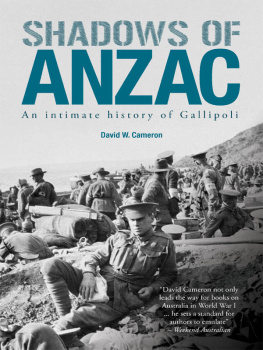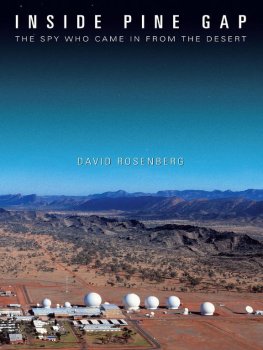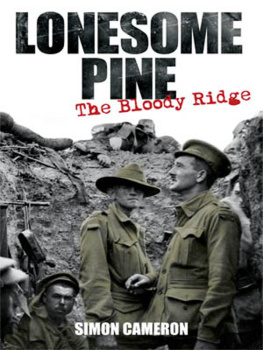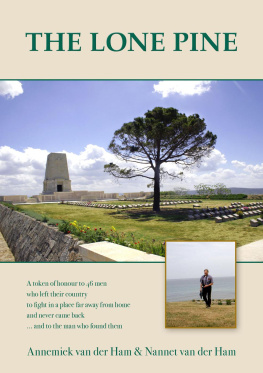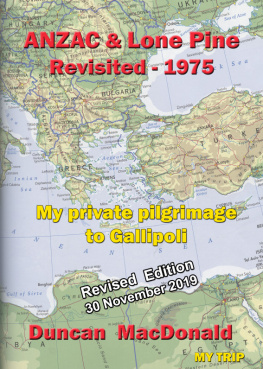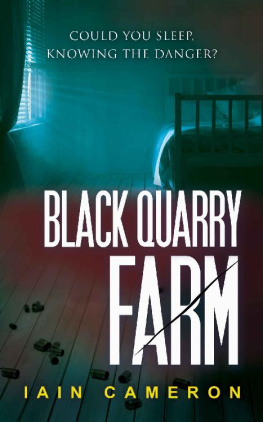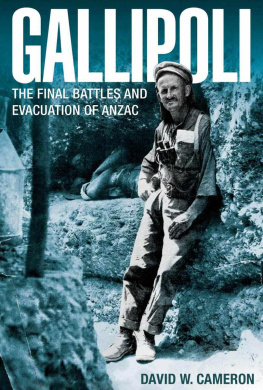David W. Cameron - The Battle for Lone Pine
Here you can read online David W. Cameron - The Battle for Lone Pine full text of the book (entire story) in english for free. Download pdf and epub, get meaning, cover and reviews about this ebook. year: 2012, publisher: Penguin Random House Australia, genre: History. Description of the work, (preface) as well as reviews are available. Best literature library LitArk.com created for fans of good reading and offers a wide selection of genres:
Romance novel
Science fiction
Adventure
Detective
Science
History
Home and family
Prose
Art
Politics
Computer
Non-fiction
Religion
Business
Children
Humor
Choose a favorite category and find really read worthwhile books. Enjoy immersion in the world of imagination, feel the emotions of the characters or learn something new for yourself, make an fascinating discovery.

- Book:The Battle for Lone Pine
- Author:
- Publisher:Penguin Random House Australia
- Genre:
- Year:2012
- Rating:5 / 5
- Favourites:Add to favourites
- Your mark:
- 100
- 1
- 2
- 3
- 4
- 5
The Battle for Lone Pine: summary, description and annotation
We offer to read an annotation, description, summary or preface (depends on what the author of the book "The Battle for Lone Pine" wrote himself). If you haven't found the necessary information about the book — write in the comments, we will try to find it.
The Battle for Lone Pine — read online for free the complete book (whole text) full work
Below is the text of the book, divided by pages. System saving the place of the last page read, allows you to conveniently read the book "The Battle for Lone Pine" online for free, without having to search again every time where you left off. Put a bookmark, and you can go to the page where you finished reading at any time.
Font size:
Interval:
Bookmark:


David W. Cameron completed his PhD in 1995 and was awarded an Australian Research Council (ARC) Postdoctoral Fellowship at the Australian National University (School of Archaeology), followed by an ARC QEII Fellowship at the University of Sydney (Department of Anatomy & Histology). He has published a number of books on science and Australian military history, including Sorry lads, but the order is to go: The August Offensive, Gallipoli 1915. He has also published over sixty scientific papers in internationally peer-reviewed journals. David lives in Canberra with his wife Deb and their three children, Emma and twins Anita and Lloyd (and their dogs Mollie and Robbie).
A rush of adrenaline mixed with fear gripped 27-year-old Private Cecil McAnulty, from Middle Park, Victoria, as he and his mate Frank charged across no-mans-land, on a plateau in the hills of the Gallipoli Peninsula not far from the coast, towards the Turkish stronghold nicknamed Lone Pine. As members of the 3rd Australian Infantry Battalion, they were in the centre of the attacking waves sweeping towards the covered trenches on the west of the plateau, on 6 August 1915. Artillery shells exploded all around and machine-gun bullets ripped into their fellow men in khaki scrambling to meet the enemy. Cecil saw men either side of him trip over the thick knotty roots of shredded scrub, while others got momentarily tangled in scraps of barbed wire that littered the killing field; some fell and never got up. Officers yelled orders that couldnt be heard above the deafening sound of exploding ordnance. The paddock erupted into thousands of tiny explosions of dirt as bullets and shrapnel kicked into the dry barren ground. Larger eruptions caused by high-explosive shells sent geysers of earth skyward. Men disappeared in the smoke and dust, or, hideously disfigured and dying, yelled for help, as others charged past, oblivious or terrified, desperate to escape the same fate. Both Cecil and Frank thanked their lucky stars as they reached the Turkish trenches. Cecil later wrote in his diary: I cant realise how I got across it, I seemed to be in a sort of a trance. The rifle & machine gun fire was hellish. Frank and three others followed him and jumped for cover behind a Turkish parapet.
Less than fifty metres away, 22-year-old Lance Corporal Joseph Aylward and 24-year-old Private George Hayward, of the 4th Australian Infantry Battalion, were attacking the northern flank of Lone Pine. They were to secure trenches and stop the Turks from across the narrow gully to the north from rolling up the Australian lines. A machine gun to their right was spraying streams of lead across no-mans-land. George lit the fuse of one of his homemade jam-tin bombs with the cigarette dangling from his lips and quickly dropped the hissing projectile into the partly covered Turkish machine-gun pit the resulting explosion silenced the gun. As George and Joseph pressed on, they realised that they were in danger of heading off the plateau battleground and descending into the gully below. Joseph turned back to see men from the second and third waves of the attack now struggling to reach the enemy trenches, as the Turks on the northern side of the gully awoke to the charge. His small party made an easy target too. Some fell, a crimson patch quickly staining the gritty ground around them. George, Joseph and the others dived into an open communication trench just in front and reluctantly made their way down into the gully, not knowing what awaited them.
On the southern side of Lone Pine, a new arrival to the peninsula, 25-year-old clerk Lieutenant Charles Lecky, set his eyes on a spot
Melbourne solicitor and citizen soldier 38-year-old Lieutenant Colonel Harold Pompey Elliott, commander of the 7th Australian Infantry Battalion, was anxiously watching the charge through a trench periscope just north of the attack, immediately opposite the Turkish lines at Johnstons Jolly, as the position across the gully from Lone Pine was known. The periscope had been carefully wrapped in hessian and fixed against a sandbag parapet, in the hope the camouflage might save it from Turkish sniper fire for a few hours at least. He knew that if the attack failed, his own men were to be thrown against the trenches at the Jolly, which were judged to be more heavily defended than Lone Pine. But even if they were successful, Elliott and his men were not out of the woods they were slated to reinforce Lone Pine, which itself would be a treacherous task in such conditions. Indeed, so fierce was the struggle ahead of them that, within days, four of his men would be awarded the Victoria Cross for their outstanding valour in the fight to hold Lone Pine.

After the first few days of the Gallipoli landings by British Empire and French troops, on 25 April 1915, most had resigned themselves to stalemate. But, with their reputations at stake, the senior British and French commanders at Helles the southern tip of the peninsula insisted on trying to break through the Turkish lines. To salvage the campaign, and perhaps their careers, they would expend the lives of huge numbers of their men. About eighteen kilometres further north, below the hills that form the southern end of the formidable Sari Bair Range, on a beach they named Anzac Cove, the men of the Australian and New Zealand Army Corps (ANZAC) had more than enough on their hands just trying to defend their precarious foothold on 160 hectares of Turkish soil. The idea of advancing beyond the coastal ridges and cutting off the southern reaches of the peninsula to Turkish reinforcements was likely far from their minds.
Yet, within months of the landing, that was the objective: to sever the peninsula west to east, isolating the Turkish garrison at Helles and silencing the guns that were blocking the advance of the combined British and French fleets through the Dardanelles.
By June, General Ian Hamilton, commander of the Mediterranean Expeditionary Force (charged with occupying the Gallipoli Peninsula) and his subordinate, Lieutenant General William Birdwood (commander of the Anzac sector), had decided to pin all of their hopes of breaking the Turkish defences on the launch of an offensive immediately north of Anzac Cove, in order to occupy the dominating heights of the Sari Bair Range before pushing east to the Dardanelles. To further assist in future operations, another landing about ten kilometres north at Suvla Bay would be incorporated into the August Offensive.
To help draw Turkish attention and troops away from the northern heights of Sari Bair, a feint was designed to keep the Turks focused on their southern flank. This would be an attack by the men of the 1st Australian Division against the well-entrenched and
The battle for Lone Pine, 69 August 1915, has rightfully gone down in Australian military history as one of the toughest and most brutal ever fought by Australians in any war. It comprised four days of intense hand-to-hand fighting and bombing in an area covering just a few hectares, with Australian and Turkish trenches often just a few metres apart. Men used anything at hand to gain an advantage in the close confines of the Pine, including fists, bayonets, knives, rifle butts and entrenching tools. Indeed, close to 2800 Australians became casualties during these four days, and Turkish casualties were said to be at least double that number. Unlike most battles in the Great War, casualties at Lone Pine were not dominated by artillery and machine-gun fire, but from small arms, bayonets and homemade bombs (grenades). In the claustrophobic maze of trenches, clogged with the dead and dying, surprise encounters resulting in fierce isolated skirmishes, and the sudden appearance of a bomb, which might be lobbed back and forth several times before it exploded, added psychological horrors to the harrowing ordeal.
Font size:
Interval:
Bookmark:
Similar books «The Battle for Lone Pine»
Look at similar books to The Battle for Lone Pine. We have selected literature similar in name and meaning in the hope of providing readers with more options to find new, interesting, not yet read works.
Discussion, reviews of the book The Battle for Lone Pine and just readers' own opinions. Leave your comments, write what you think about the work, its meaning or the main characters. Specify what exactly you liked and what you didn't like, and why you think so.

